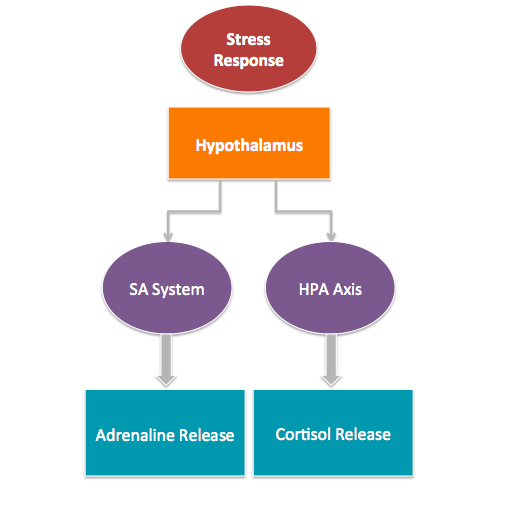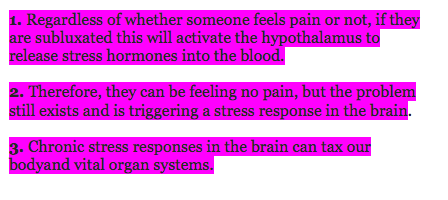
Feeling like stress has you by the short and curlies? You can’t sleep but you’re bone tired? You’re having heart palpitations and finding it hard to catch a full breath?
Then consider how long has it been since you committed to regular wellness adjustments?
New research shows that regular chiropractic adjustments may be extremely beneficial to people suffering from ongoing stress. In the last post, “Looking at Stress Head On” we looked at 10 Ways To Minimise Stress and I promised to go through some of the rationale of why seeing your chiropractor helps you bounce back from stress.
Here’s the deal:
The brain and nervous system govern all other systems of the body and all bodily functions.
The nervous and endocrine systems often act together in a process called neuroendocrine integration, to regulate the physiological (physical) processes of the human body. They form the neuroendocrine system and contain neuroendocrine cells, which the hypothalamus (a section of the brain responsible for the production of many of the body’s essential hormones) utilises to maintain homeostasis (balance) in the body regulating reproduction, metabolism, mood, energy utilization, sex drive and blood pressure for example.
Firstly, our body judges a situation and decides whether or not it is stressful. This decision is made based on sensory input and processing (i.e. the things we see and hear in the situation) and also on stored memories (i.e. what happened the last time we were in a similar situation).
If the situation is judged as being stressful, the Hypothalmus (at the base of the brain) is activated. The hypothalamus coordinates the release of very specific hormones by activating two specific systems the Hypothalamic-Pituitary Adrenal Axis or the HPA axis and another called the Sympatho-Adrenal System or SA system.
A stress response generally produces:
• Increase in heart rate
• Increase in breathing (lungs dilate)
• Decrease in digestive activity (don’t feel hungry)
• Liver released glucose for energy

Short-term this is fine, Long-term… it’s harmful.
The sympatho-adrenal system (SA system) releases adrenaline to increase all kinds of energy in the brain, heart and muscles. This is super ‘short term’ but when the stress doesn’t shift, when it doesn’t lift, then the body continues to utilize blood from these areas and is forced to decrease blood flow to lower priority systems such as the gastro-intestinal system and reproductive system. So chronic stress can take life force from other parts of the body, depleting them.
The other system that’s activated with a stress response is the HPA Axis, that causes cortisol to be released to increase blood pressure amongst other things. Now cortisol short term again, is fine but when “cortisol is sustained,” the body has to also take energy from other areas including the immune system and reproductive system. The body doesn’t want to sustain cortisol, that is not its mission, it just has to do that because the stressor has not passed.
Now here’s the thing,
Repeated stimulation of those hormones from CHRONIC stress can cause target tissues to become resistant, which can with time initiate disease and illness.
How Do Adjustments Help?

One of the basic founding principals of chiropractic is that there are physical, chemical and emotional causes for subluxations. Stress is an emotional cause of subluxation.
Nerve messages can be impaired by these spinal subluxations which results in altered joint motion and impaired nerve function.
It has been our understanding that by removing subluxations or nerve interference we help the body to balance the impact of stress. Over the last few decades’ advancements in our understanding of neurology however have allowed chiropractors and other professionals who work in this field to better appreciate pain pathways and pain messages.
My good friend Dr John Minardi DC (bless him) has spent many hours outlining for me that this new awareness helps to explain that regardless of whether a person is feeling pain or not, if they are subluxated (remembering stress is a cause of subluxation) then this activates the hypothalamus to release stress hormones into the blood. Therefore, a person can be feeling no pain, but the problem still exists and is triggering a stress response in the brain.
Let’s make this clear, what this means is:

Chiropractic because of its direct influence on the neuro -endocrine system works to balance our hormones and stress cycles.
Obviously it is both the severity of the subluxation and the length of time it has been left uncorrected that dictates the decline and impact on body function.
Please note while chiropractors adjust the spine to help remove these subluxations, adjustments are NOT a band aid-cure for stress.
Why not?
Because it is always the job the human body to cure and recreate balance and it may not be able to do that well, or for very long if there are a multitude of factors in your life that consistently tax your body and recreate phycial, chemical and emotional stress.
Remembering that poor diet, toxicity, lack of sleep and exercise all tip the scales towards overload and imbalance. We need to invest in all sectors of our health:
• Wholesome food
• A well adjusted nervous system
• Quality exercise and sleep
• Filtered water and minimal toxins
• Positive happy thoughts
If we neglect certain areas the body will struggle to recreate balance.
Here are some summaries on recent research studies on how chiropractic adjustments help to relieve symptoms of stress:
Tuchin found “Salivary cortisol levels a measure of stress decreased over a 5 week adjustment period.”
Haavik’s research clearly showed that cervical spinal adjustments on asymptomatic subjects (patients with no symptoms but with confirmed vertebral subluxations) influenced the cortical brain and created neuroplastic changes in the brain tissue.
“It was noted that “enhanced active inhibition” of the sympathetic nervous system tone occurred in ALL post-adjustment measurements and the control groups (also asymptomatic but not given actual adjustments) had NO cortical neuroplastic change.”
This means they were able to measure how adjustments calmed the sympathetic nervous system in people who had no symptoms and were given adjustments.
Ogura (chiropractor) and 8 PhD’s revealed the impact of “one single chiropractic adjustment can have on the tone of the nervous system demonstrating:
• Sympathetic tone of the nervous system was inhibited (decreased)
• Salivary amylase was decreased (indicating a decrease in fight/ flight physiology)
• Regional brain metabolic changes occurred,
• Muscle tone and pain intensity decreased.”
Plaza-Manzano in this study 30 asymptomatic university students, were given cervical, thoracic adjustments or placebo. Blood samples were taken before, immediately after and two hours later.
The scientists sought to understand how hormones change in response to chiropractic adjustments. They found that neurotensin and oxytocin significantly rose, and cortisol levels rose after thoracic adjustments. These hormonal changes provide not only pain relief but also long term benefits for emotional wellbeing and overall body function.
While research is still being gathered it appears that Chiropractic care helps create hormonal balance and a healthy and well-adjusted spine is one key to effectively managing stress!

For more information on managing stress, please refer to Chapter 2, 3, 4 and 21 of my book Well Adjusted Babies 2nd Edition
Yours in health,
. . . . .
 Yours in Health,
Yours in Health,
Jennifer Barham-Floreani
(Bach. Chiropractic, Bach. App Clinical Science
Registered internationally, no longer practicing as a chiropractor in Australia.)
. . . . .
Want to learn more about how to live a healthy lifestyle? For more health related information, please see Well Adjusted Babies 2nd Edition.
1. Byers MR and Bonica JJ (2001) Peripheral pain mechanisms and nociceptor plasticity, in Bonica’s Management of Pain (Loeser LD, Butler SH, Chapman CR and Turk DC eds) 3rd ed, pp 26–73 Lippincott Williams & Wilkins, Philadelphia.
2. Currie, A. R., & Symington, T. (1955). The pathology of the pituitary and adrenal glands in systemic disease in man. Proceedings of the Royal Society of Medicine, 48(11), 908.
3. Morgan LG. Psychoneuroimmunology, the placebo effect and chiropractic. Journal of Manipulative and Physiological Therapeutics 1998; 21(7): 484-491.
4. Minardi, J. Neurology of the Vertebral Subluxation Complex. 2012. www.MinardiEducation.com
5. Haavik Taylor, H. & Murphy B.A. (2007) “Cervical spine manipulation alters sensorimotor integration: A somatosensory evoked potential study” Journal of Clinical Neurophysiology, 118(2):391-402.
6. “Cerebal Metabolic Changes in Men After Chiropractic Spinal Manipulation for Neck Pain.” Authors: Ogura Takeshi, DC, PhD; Tashiro Manabu, MD, PhD; Masud Mehedi, MD, PhD; Watanuke, Shoichi; Shibuya, Katsuhiko, MS; Yamaguchi, Keiichiro, MD, PhD; Itoh, Masatoshi, MD, PhD; Fukuda, Hiroshi, MD, PhD; Yani, Kazuhiko, MD, PhD. ProQuest May 10th 2014.
7. “The Effect of Chiropractic Spinal Manipulative Therapy on Salivary Cortisol Levels.” Author: Peter J. Tunchin B.Sc., Grand.Dip.(chiro).Dip.(OHS).* ACO Volume 7. Number 2. July 1998.



